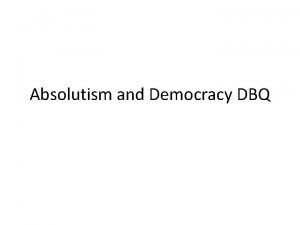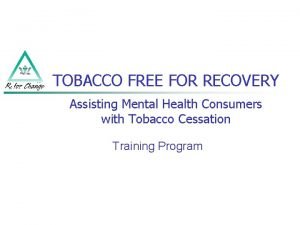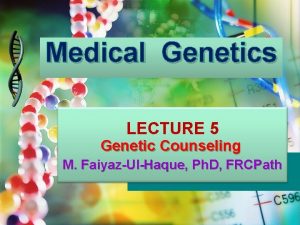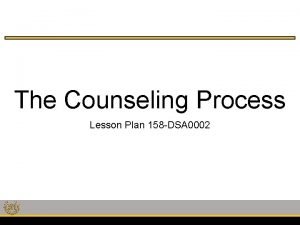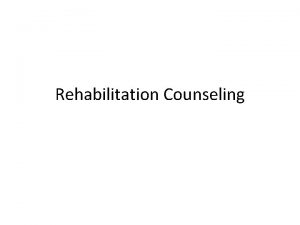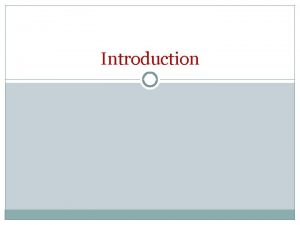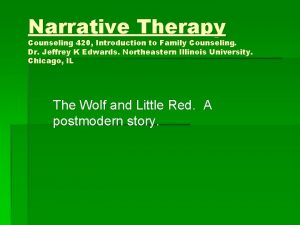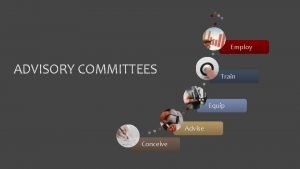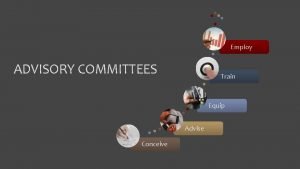Counseling Counseling Introduction n Definition to advise recommend

























- Slides: 25

Counseling

Counseling Introduction n Definition: to advise, recommend, guide, and exchange ideas and opinions n GOAL OF COUNSELING: facilitate changes in a person’s behavior

Education is the process of providing factual information and clarification about a topic to an individual or group. Counseling is the act of helping a client to make her/his own decision, by providing unbiased information and asking questions about what the client wants and what the client thinks that he/she can do.

Counseling is a special process. It is a confidential dialogue between a medical provider and a client that helps a client to define his or her feelings and to cope with stress. Usually people need training to be a good counselor.

Tools for effective counseling Communication skills. 2. Technical information. 3. Understanding the stages of the counseling process. 1.

Counselor’s Task n Essential task of a counselor: ” assisting individuals work toward an understanding of themselves in order to learn new ways of coping with and adjusting to either negative life situations or those to which they may respond negatively or unrealistically

Counseling Process Counseling process is supportive, insight reeducative, and usually short term n When considering the counseling process, think of a beginning, a middle and an end – each with main areas of focus/tasks n Used to help individuals make practical changes in their lives without necessarily modifying established personality pattern n

Six Stages Stage One: Relationship building Stage Two: Assessment and diagnosis Stage Three: Formulation of counseling goals Stage Four: Intervention and problem solving Stage Five: Termination and Follow Up Stage Six: Research and evaluation

10 Fundamentals for Counseling n Rarely be a problem solver; help guide the client to coming up with own solutions n Trust your intuition n Provide a sense of direction for the client

10 Fundamentals for Counseling n Take care of your client; protect his/her feelings; help him/her move at own pace n Have a sense of humor n Incorporate self-disclosure as an important part of counseling; show that you are willing to share as well.

10 Fundamentals for Counseling n Be open-minded n Believe that clients are doing the best that they can n mutual agreement on expectations for therapy between you and your client is essential n Ask client for feedback Blood (1995)

Group counseling

Types of Groups • Task Groups: A group that comes together to perform a task that has a concrete goal (e. g. community organizations, committees, planning groups). • Guidance/Psychoeducational Group: Preventative and educational groups that help group members learn information about a particular topic or issue and might also help group members cope with that same issue (e. g. support group for a suicide, transition group to prepare students to enter high school etc. )

Types of Groups (continued) • Counseling/Interpersonal Problem. Solving Groups: These groups help participants resolve problems of living through interpersonal support and problem solving. • Psychotherapy Groups: These groups focus on personality reconstruction or remediation of deep-seated psychological problems.

Types of Groups (continued) • Support Groups: These deal with special populations and deal with specific issues and offer support, comfort, and connectedness to others. • Self-help Groups: These have no formal or trained group leader. (e. g. Alcoholics Anonymous or Gamblers Anonymous. )

Advantages of Groups • Members can test out and practice new behaviors. • Members can practice new skills. • They are cost effective. • Groups help members see that they are not the only one who has that particular problem or issue. • Groups provide members with support.

Disadvantages of Groups • Less individualized attention from the counselor. • Confidentiality is more difficult to maintain. • Not everyone can be in a group (e. g. those with issues too severe) • Group leaders are not always properly trained.

Stages of Groups • Stage One (Orientation/Forming): Group members become oriented to the group and to each other. • Stage Two (Transition/Storming): Anxiety and ambiguity become prevalent as group members struggle to define themselves. This stage is often characterized by conflict.

Stages of Groups (continued) • Stage Three (Cohesiveness/Norming): A therapeutic alliance forms between group members. Trust between members has been established. • Stage Four (Working/Performing): Group members experiment with new ideas, behaviors or ways of thinking. • Stage Five (Adjourning/Terminating): This is the time when the group disbands.

Leadership Styles • Authoritarian: Leader centered. • Democratic: Participant centered. • Laissez-Faire: No designated leadership.

Leadership Functions • Emotional Stimulation: Challenging, confronting, self-disclosure etc. • Caring: Showing support, praise, warmth, acceptance etc. • Meaning Attribution: Explaining, clarifying, interpreting etc. • Executive Function: Setting limits, providing rules, managing time etc.

Group Leadership Techniques • Facilitating communication: Giving constructive feedback, preventing members from engaging in negative behaviors (gossiping, storytelling etc. ) • Group Processing: Making comments on group process to keep the group therapeutic and attending to group dynamics. • Directing the Focus on the Here and Now: Keeping the focus on right now and not going back to dwell on the past.

Group Leadership Techniques (continued) • Experimentation: Helping members try out new attitudes and behaviors. • Universalizing: Helping members realize they are not alone in their problem(s). • Linking: Connecting various feelings and concerns expressed by group members to present a common theme or universalizing aspect.

n In Conclusion conclusion, there are many types of treatment methods out to facilitate fluency. n It is clear that no matter what, there is no quick fix. n All methods are going to take hard work and determination to be successful. n Likewise, the type of treatment approach must depend on the person and their support system.

End of Lectures
 What type of government does king louis describe
What type of government does king louis describe I strongly recommend this book
I strongly recommend this book We recommend against
We recommend against A ratio compares
A ratio compares Argue and persuade
Argue and persuade Who does creon advise oedipus to send for?
Who does creon advise oedipus to send for? Need verb pattern
Need verb pattern Doctor advise
Doctor advise Cappuccino romman shisha
Cappuccino romman shisha Special introductory verbs
Special introductory verbs Ask assess advise
Ask assess advise Shipping advise
Shipping advise Peter fitch clothing
Peter fitch clothing Troidens model
Troidens model Genetic counseling definition
Genetic counseling definition Housing counseling definition
Housing counseling definition Introduction paragraph format
Introduction paragraph format Counseling vs therapy
Counseling vs therapy Woodland community college counseling
Woodland community college counseling Role play counseling script examples
Role play counseling script examples Una counseling services
Una counseling services Difference between counseling and advice
Difference between counseling and advice Five levels of consciousness
Five levels of consciousness Serial 7s
Serial 7s Stages of counseling army
Stages of counseling army Ouhsc writing center
Ouhsc writing center
